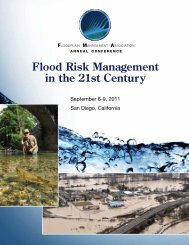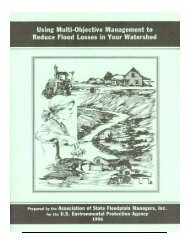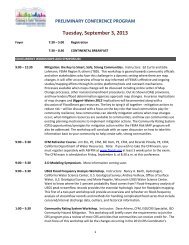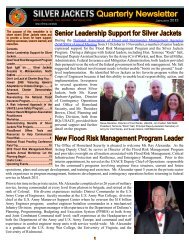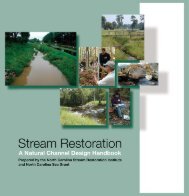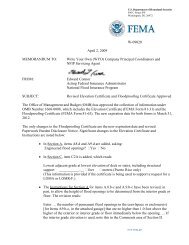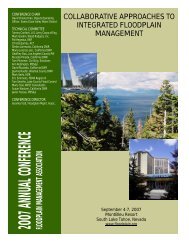Using Plants to Improve Flood Management - Floodplain Management
Using Plants to Improve Flood Management - Floodplain Management
Using Plants to Improve Flood Management - Floodplain Management
You also want an ePaper? Increase the reach of your titles
YUMPU automatically turns print PDFs into web optimized ePapers that Google loves.
Type of Channel and Description<br />
Minimum Normal Maximum<br />
Natural streams - minor streams (<strong>to</strong>p width at floodstage < 100 ft)<br />
1. Main Channels<br />
a. clean, straight, full stage, no rifts or deep pools<br />
b. same as above, but more s<strong>to</strong>nes and weeds<br />
c. clean, winding, some pools and shoals<br />
d. same as above, but some weeds and s<strong>to</strong>nes<br />
0.025 0.030 0.033<br />
0.030 0.035 0.040<br />
0.033 0.040 0.045<br />
0.035 0.045 0.050<br />
e. same as above, lower stages, more ineffective<br />
slopes and sections<br />
0.040 0.048 0.055<br />
f. same as "d" with more s<strong>to</strong>nes 0.045 0.050 0.060<br />
g. sluggish reaches, weedy, deep pools 0.050 0.070 0.080<br />
h. very weedy reaches, deep pools, or floodways<br />
with heavy stand of timber and underbrush<br />
0.075 0.100 0.150<br />
2. Mountain streams, no vegetation in channel, banks usually steep, trees and brush<br />
along banks submerged at high stages<br />
a. bot<strong>to</strong>m: gravels, cobbles, and few boulders 0.030 0.040 0.050<br />
b bot<strong>to</strong>m: cobbles with large boulders<br />
0.040 0.050 0.070





